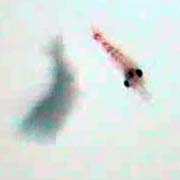|
Krill watching
[2009-02-16]
animation: Lisa Roberts
Sydney 2008
story: Steve Nicol
Marine Scientist, Australian Antarctic Division, 2009
I think that in order to do the sorts of things that we do,
we have to have some sort of appreciation for what goes on out there,
some sort of feel for it.
Steve Nicol, Hobart, 2009

Detail from KRILL CAM
Australian Antarctic Division, 16 Feb 2009
The animation was made after watching and drawing adult krill
at the Australian Antarctic Division's krill nursery and hearing Steve's story
of first seeing krill in the open sea.
Steve's direct encounter with krill changed for ever how he understands them.
He understands that Krill have individual and collective behaviours and,
like all living things, krill are shaped by their environment.
Like us, they shape their environment to suit them.
'It's a two-way street', he says.
Steve's story is set in the Bay of Fundy, Canada, where he went out in a small boat with a local fisherman to observe krill.
I remember that first day we went out. It was a mirror calm day, and you could detect where the swarms of krill were by where the birds were landing on the water. So we followed the birds. You could see the water changing texture as the swarms of krill touched the surface. Occasionally they jumped out, and, as they swam around with their antennae on the surface, they caused their own little ripples in the water.
There was something odd going on, and we stopped the boat to try and sample some of these swarms. We saw a little school of krill swimming along past the boat, and one of the krill just broke away, and came over towards us. It just sort of sat there, with his antennae sitting on top of the water, with its big black eyes, just looking at us. I looked at it, and it looked at me, and the old fisherman looked at it, and looked at me, and we all looked at each other. Then the little krill decided it had checked us out enough and quickly scurried off across the water to join the rest of the school.
Now it was at that point that I realised these are really animals, and that they actually have lots of interesting behaviours. This was really different to what we had been taught at university, where they had been referred to as bugs. We had bug counters, and towed nets through the water to estimate how many there were.
From that moment, in the Bay of Fundi, the way I looked at krill changed completely. I realised that almost everything that you we about krill is affected by the way that they behave, and that you can't just treat them like passive particles in the water, or physical objects. I still think that. And that was 30 years ago.
After telling his story, Steve opened Alister Hardy's book of water-colours (Hardy, 1956). He showed me examples of krill depicted as 'beautiful creatures', connected to their environments.
Steve led me downstairs to see the krill nursery, where masses of lively krill were swimming around in large tanks. I met scientists working with them to understand the effects on krill development of increasing levels of CO2 in the ocean.
Just as I was leaving, there was great excitement in the room as a live krill could be seen, on a large video screen, emerging from its egg.
The following day, as I drew krill in the nursery, I remembered Steve's story, and I saw them differently. Steve's storytelling, these drawings, and memories of seeing the birth of a krill, were the inspiration to animate Energies. This animation evolved to combine scientific data with subjective responses to Antarctica. Energies combines many visions of Antarctica.
| 